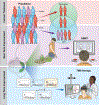Current and Future Approaches to Pediatric Anxiety Disorder Treatment
- PMID: 38425255
- PMCID: PMC11256210
- DOI: 10.1176/appi.ajp.20231037
Current and Future Approaches to Pediatric Anxiety Disorder Treatment
Abstract
This overview critically appraises the literature on the treatment of pediatric anxiety disorders. The two established treatments for these conditions comprise cognitive-behavioral therapy (CBT) and antidepressant medications. Many youths receiving these treatments fail to achieve remission, which creates a need for new treatments. After summarizing the literature on CBT and currently available medications, the authors describe research that lays a foundation for improvements in the treatment of pediatric anxiety disorders. This foundation leverages neuroscientific investigations, also described in the overview, which provide insights on mechanisms of successful treatment.
Keywords: Antidepressants; Anxiety Disorders; Child/Adolescent Psychiatry; Psychotherapy; SSRIs.
Conflict of interest statement
The authors report no financial relationships with commercial interests.
Figures

Similar articles
-
Treatment of childhood anxiety disorders: what is the place for antidepressants?Expert Opin Pharmacother. 2012 Jan;13(1):43-64. doi: 10.1517/14656566.2012.642864. Expert Opin Pharmacother. 2012. PMID: 22149367 Review.
-
Approaches for discontinuation versus continuation of long-term antidepressant use for depressive and anxiety disorders in adults.Cochrane Database Syst Rev. 2021 Apr 15;4(4):CD013495. doi: 10.1002/14651858.CD013495.pub2. Cochrane Database Syst Rev. 2021. PMID: 33886130 Free PMC article.
-
Antidepressants for people with epilepsy and depression.Cochrane Database Syst Rev. 2021 Apr 16;4(4):CD010682. doi: 10.1002/14651858.CD010682.pub3. Cochrane Database Syst Rev. 2021. PMID: 33860531 Free PMC article.
-
Benefits of Sequentially Adding Cognitive-Behavioral Therapy or Antidepressant Medication for Adults With Nonremitting Depression.Am J Psychiatry. 2019 Apr 1;176(4):275-286. doi: 10.1176/appi.ajp.2018.18091075. Epub 2019 Feb 15. Am J Psychiatry. 2019. PMID: 30764648 Free PMC article. Clinical Trial.
-
Treatments for generalized anxiety disorder.Expert Rev Neurother. 2004 Mar;4(2):285-94. doi: 10.1586/14737175.4.2.285. Expert Rev Neurother. 2004. PMID: 15853570 Review.
References
-
- Locher C, Koechlin H, Zion SR, Werner C, Pine DS, Kirsch I, Kessler RC, Kossowsky J. Efficacy and Safety of Selective Serotonin Reuptake Inhibitors, Serotonin-Norepinephrine Reuptake Inhibitors, and Placebo for Common Psychiatric Disorders Among Children and Adolescents: A Systematic Review and Meta-analysis. JAMA Psychiatry. 2017;74:1011–1020. - PMC - PubMed
-
- Ginsburg GS, Becker-Haimes EM, Keeton C, Kendall PC, Iyengar S, Sakolsky D, Albano AM, Peris T, Compton SN, Piacentini J. Results From the Child/Adolescent Anxiety Multimodal Extended Long-Term Study (CAMELS): Primary Anxiety Outcomes. J Am Acad Child Adolesc Psychiatry. 2018;57:471–480. - PubMed
-
- Pine DS, Fox NA. Childhood antecedents and risk for adult mental disorders. Annu Rev Psychol. 2015;66:459–485. - PubMed
Publication types
MeSH terms
Substances
Grants and funding
LinkOut - more resources
Full Text Sources

